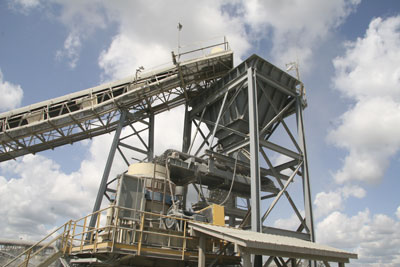
Products & Equipment
Pits & Quarries
Tracked MTV targets multiple applications
A relatively new arrival on the Material Transfer Vehicle (MTV) scene
October 22, 2009 By Andy Bateman
Since their introduction some 20 years ago, Material Transfer Vehicles
(MTV’s) have become common sights on asphalt paving projects. A
relatively new arrival on the scene promises improved manoeuvrability
and a broad application range in addition to MTV’s established benefits.
Since their introduction some 20 years ago, Material Transfer Vehicles (MTV’s) have become common sights on asphalt paving projects. A relatively new arrival on the scene promises improved manoeuvrability and a broad application range in addition to MTV’s established benefits.
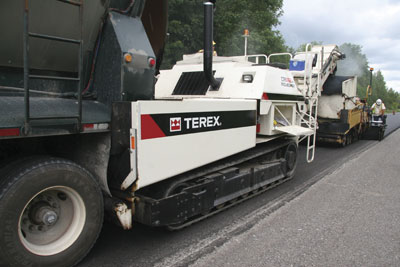
|
|
| The rubber tracked Terex Cedarapids CR662RM can serve as both material transfer vehicle and remix paver. |
Aggregates & Roadbuilding saw the unit on a county road paving contract being completed by Norway Asphalt Limited, a joint venture between Miller Paving Limited & Drain Brothers Excavating Limited. The pavement rehabilitation and maintenance project on County Road 45 north of Cobourg Ont., extended 2.8 km from Pioneer Road to County Road 22. Norway Asphalt’s site superintendent Keith Ibbotson explains that hot mix asphalt on the 8.5 m wide, two lane road included a 50 mm lift of HL8 base mix followed by a 40mm thick compacted mat of HL3 surface mix, with all the asphalt supplied from Norway Asphalts’ Norwood hot mix asphalt plant. Multiple aggregate sources for the HL3 mixture included limestone coarse aggregate from the company’s Dummer Township limestone quarry, manufactured sand (crushed rock fine aggregate) from Drain Bros.’ recently acquired Havelock quarry and natural sand from Drain Bros.’ Oitment Pit. Aggregates for the HL8 base mix were sourced from the Havelock quarry and Oitment pit.
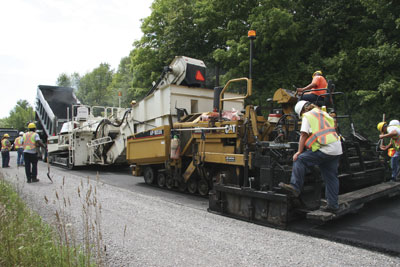 |
|
| The asphalt was remixed by the CR662RM before being discharged into the hopper of a Caterpillar AP 1055B paver equipped with Topcon grade Control and an Extend-A-Mat screed 10-20B screed. | |
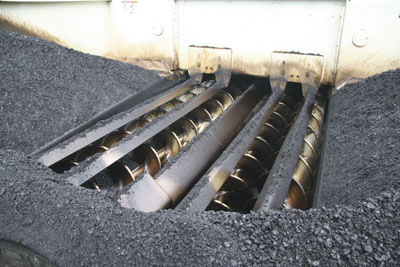 |
|
| Material was drawn from the CR662M’s hopper by interleafing augers and remixed in a figure of eight motion. | |
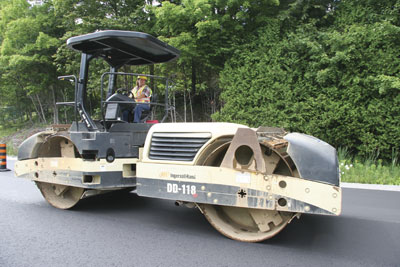 |
|
| A Volvo Ingersoll-Rand DD-118HF made two vibratory passes in the breakdown position on the number three drum setting. |
During normal operation, trucks arriving from the Norwood plant discharged into a Terex Cedarapids CR662RM RoadMix Machine at the head of the paving train. The asphalt was remixed by the CR662RM before being discharged into the hopper of a Caterpillar AP 1055B paver equipped with Topcon grade Control and an Extend-A-Mat screed 10-20B screed. The compaction train behind the paver included a Volvo Ingersoll-Rand DD -118HF making two vibratory passes in the breakdown position while a Caterpillar PF 300B pneumatic compactor in the secondary position made seven passes. A Bomag BW -141 AD-2 dual steel drum compactor finished the mat, with the three compactors achieving the target mat density of 94.5%.
The CR662RM shares a number of benefits with other MTV’s, including the increased site inventory of asphalt that helps maintain a steady feed to the paver. MTVs also provide physical separation between delivery trucks and the paver to avoid the old issue of paver bumping and the resulting irregularities in the finished mat. Most important perhaps, the remixing action of MTV’s means that the paver receives a homogenous mixture with uniform gradation and temperature for improved mat quality.
In Ibbotson’s view, the CR662RM is well suited to medium scale work such as county roads, commercial projects and city streets where its manoeuvrability and low ground pressure can be useful characteristics. This particular unit went into service at the beginning of the 2009 construction season and Ibbotson reports no operating problems or mechanical issues to date.
Within the unit, material is drawn from the hopper through interleafing augers and mixed in a figure of eight motion. Material then passes through a transfer conveyor pickup auger mounted at 90 degrees to the remix auger before entering the unit’s transfer slats. Remixing of the asphalt mixture takes place as the augers transfer material from the feed hopper and again in the C2 and C3 flights before discharging onto the conveyor feeding the hopper of the paver. As a result, says Terex, the machine does not hold asphalt for long periods of time and delivers a consistent mix temperature from truck to mat.
The total surge capacity of the CR662RM is listed as up to 39 tonnes, based upon the use of a 500 Series paver with a large hopper insert. In operation, the discharge conveyor swivels 55º left or right of center for off-set paving, while a sonic feed control system automatically stops the interleafing hopper augers when the recycling paver hopper or hopper insert is full.
One of the important characteristics of the CR662RM’s design, adds Terex, is the low ground pressure exerted by its rubber tracks. The machine applies 145 kPA (21 psi) underneath the tracks or about 20 per cent of the ground pressure applied by the wheels of its principal competitor. As a result, the CR662RM can be used on all asphalt lifts, including base lifts where the unit is travelling on compacted granular base material rather than a paved surface. Lower pressure also minimises the tendency for the CR662RM to scrub or tear newly placed asphalt while turning and, coupled with a low centre of gravity, improves machine stability on granular base surfaces. Independent hydrostatic drive for each track allows the CR662RM to rotate on its own axis if necessary in tight locations.
The CR662RM is unusual insofar as the unit can serve as both MTV and remix paver. The reported conversion time from MTV to paver is about a half day and utilizes a paver conversion kit. In either mode, the machine operator can see the level of material in the hopper and does not need a dump man. Paver screed options include the Stretch 20 screed with diesel or electric heat, the electric or diesel Fastach 10 or the electric VersaScreed 210. The paver has a new spreading auger design in which outboard drive motors power left and right hand spread auger sections to deliver material to the screed. These auger sections back up to each other, leaving no separation in the centre of the screed. By eliminating a centre gearbox drive and reversing augers, this design is said to reduce the occurrence of centreline segregation.
The dual capability of the CR662RM was recently demonstrated by a finalist in the Ontario 2008 Paver of the Year awards. (Aggregates & Roadbuilding, March/April 2009). On Huron Construction Company Limited’s contract, a unit on MTV duty was teamed with a second unit on paver duty. The leading CR662RM was fitted with the conveyor assembly to transfer remixed asphalt from the delivery trucks to the paver, while the second CR662RM following immediately behind was equipped with a Stretch 20 screed, electric screed control heating system and Topcon’s System Five automatic machine control system.
The CR662RM has an operating speed of up to 68.6 m/min and a travel speed of up to 15.5 km/h. The unit is powered by a Cummins Tier 3 turbocharged diesel engine delivering 194 kW 2,200 rpm. For transportation, the tractor unit weighs 17.8 tonnes, increasing to 24.0 tonnes with the conveyor assembly attached or 21.9 tonnes with the Stretch 20 Screed attached. The MTV is 3.25 m wide, has an overall length of 11.4 m with the conveyor assembly attached and is 2.8 m high with the frame lowered.
| Quarry spread geared to aggregates
The 50 tonne capacity bin and belt feeder above this Nordberg 1560 Omnicone crusher keeps the crusher choke fed for optimum particle shape. Drain Bros. general manager Gary McNamara explains that former owner 3M Canada had geared the process at the 100 year old Havelock basalt quarry to the production of roofing granules. Following its acquisition by Drain Bros., the quarry plant was extensively reconfigured to maximise the production of construction aggregates and improve access to major components. Two crushers, for instance, were removed from the basement of an old five storey building and integrated into the redesigned stationary spread. About 20 per cent of the primary crusher’s output is diverted from the main material flow and directed to a separate Simplicity heavy duty screen fitted with 152 mm Dur-X-Vulcan rubber screen panels with steel backing. This screen separates the feed at 100mm to produce 150 mm by 100 mm clear and 100 mm minus products. The large clear stone is shipped to the Milton plant of Roxul Inc. and utilised in the manufacture of stone wool insulation products while the 100 minus is sold separately as a granular fill product. |
Print this page
